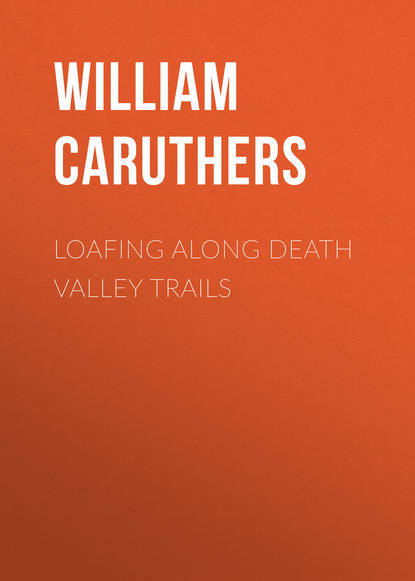По всем вопросам обращайтесь на: info@litportal.ru
(©) 2003-2024.
✖
Loafing Along Death Valley Trails
Настройки чтения
Размер шрифта
Высота строк
Поля
“I suppose,” I said aimlessly, “you’ll retire to a life of luxury; have a palace, a housekeeper, and a French chef.”
“Nope. Chinaman cook. Friend of mine struck it rich. He had a female cook. After that he couldn’t call his soul his own. Me? First money I spend goes for pie. Never had my fill of pie. Next – ” He paused and looked affectionately at Thieving Jack. “I’m going to buy a ranch over at Lone Pine with a stream running smack through the middle. Snow water. I aim to build a fence head high all around it and pension that burro off. As for me – no mansion. Just a cottage with a screen porch all around. I’m sick of horseflies and mosquitoes.”
He was off at sunrise and my thought was that God went with him and Thieving Jack.
If you encounter scorching heat you will find little comfort in the fact that icebergs once floated in those ancient seas. It is almost certain that you will be curious about the disorderly jumble of gutted hills; the colorful canyons and strange formations and ask yourself what caused it.
The answer is found on Black Mountain in the Funeral Range. Here occurred a convulsion of nature without any known parallel and the tops of nearby mountains became the bottom of America – an upheaval so violent that the oldest rocks were squeezed under pressure from the nethermost stratum of the earth to lie alongside the youngest on the surface.
The seas and the fish vanished. The forests were buried. The prehistoric animals, the dinosaurs and elephants were trapped.
The result, after undetermined ages, is today’s Death Valley. A shorter explanation was that of my companion on my first trip to Black Mountain – a noted desert character – Jackass Slim. There we found a scientist who wished to enlighten us. To his conversation sprinkled with such words as Paleozoic and pre-Cambrian Slim listened raptly for an hour. Then the learned man asked Slim if he had made it plain.
“Sure,” Slim said. “You’ve been trying to say hell broke loose.”
The Indians, who saw Death Valley first, called it “Tomesha,” which means Ground Afire, and warned adventurers, explorers, and trappers that it was a vast sunken region, intolerant of life.
The first white Americans known to have seen it, belonged to the party of explorers led by John C. Fremont and guided by Kit Carson.
Death Valley ends on the south in the narrow opening between the terminus of the Panamint Range and that of the Black Mountains. Through this opening, though unaware of it, Fremont saw the dry stream bed of the Amargosa River, on April 27, 1844, flowing north and in the distance “a high, snowy mountain.” This mountain was Telescope Peak, 11,045 feet high.
Nearly six years later, impatient Forty Niners enroute to California gold fields, having heard that the shortest way was through this forbidden sink, demanded that their guide take them across it.
“I will go to hell with you, but not through Death Valley,” said the wise Mormon guide, Captain Jefferson Hunt.
Scoffing Hunt’s warning, the Bennett-Arcane party deserted and with the Jayhawkers became the first white Americans to cross Death Valley. The suffering of the deserters, widely advertised, gave the region an evil reputation that kept it practically untraveled, unexplored, and accursed for the next 75 years, or until Charles Brown of Shoshone succeeded in having wheel tracks replaced with roads.
With the opening of the Eichbaum toll road from Lone Pine to Stovepipe Wells in 1926-7 a trickle of tourists began, but actually as late as 1932, Death Valley had fewer visitors than the Congo. A few prospectors, a few daring adventurers and a few ranchers had found in the areas adjoining, something in the great Wide Open that answered man’s inherent craving for freedom and peace. “The hills that shut this valley in,” explained the old timer, “also shut out the mess we left behind.”
Tales of treasure came in the wake of the Forty Niners but it was not until 1860 that the first prospecting party was organized by Dr. Darwin French at Oroville, California. In the fall of that year he set out to find the Lost Gunsight mine, the story of which is told in another chapter.
On this trip Dr. French discovered and gave his name to Darwin Falls and Darwin Wash in the Panamint range. He named Bennett’s Well on the floor of Death Valley to honor Asa (or Asabel) Bennett, a member of the Bennett-Arcane party. He gave the name of another member of that party to Towne’s Pass, now a thrilling route into Death Valley but then a breath-taking challenge to death.
He named Furnace Creek after finding there a crude furnace for reducing ore. He also named Panamint Valley and Panamint Range, but neither the origin of the word Panamint nor its significance is known. Indians found there said their tribe was called Panamint, but those around there are Shoshones and Piutes. (See note (#n_piute_2_3) at end of this chapter.)
Also in 1860 William Lewis Manly who with John Rogers, a brave and husky Tennessean had rescued the survivors of the Bennett-Arcane party, returned to the valley he had named, to search for the Gunsight. Manly found nothing and reported later he was deserted by his companions and escaped death only when rescued by a wandering Indian.
In 1861 Lt. Ives on a surveying mission explored a part of the valley in connection with the California Boundary Commission. He used for pack animals some of the camels which had been provided by Jefferson Davis, Secretary of War, for transporting supplies across the western deserts.
In 1861 Dr. S. G. George, who had been a member of French’s party, organized one of his own and for the same reason – to find the Lost Gunsight. He made several locations of silver and gold, explored a portion of the Panamint Range. The first man ever to scale Telescope Peak was a member of the George party. He was W. T. Henderson, who had also been with Dr. French. Henderson named the mountain “because,” he said, “I could see for 200 miles in all directions as clearly as through a telescope.”
The most enduring accomplishment of the party was to bring back a name for the mountain range east of what is now known as Owens Valley, named for one of Fremont’s party of explorers. From an Indian chief they learned this range was called Inyo and meant “the home of a Great Spirit.” Ultimately the name was given to the county in the southeast corner of which is Death Valley.
Tragedy dogged all the early expeditions. July 21, 1871 the Wheeler expedition left Independence to explore Death Valley. This party of 60 included geologists, botanists, naturalists, and soldiers. One detachment was under command of Lt. George Wheeler. Lt. Lyle led the other. Lyle’s detachment was guided by C. F. R. Hahn and the third day out Hahn was sent ahead to locate water. John Koehler, a naturalist of the party is alleged to have said that he would kill Hahn if he didn’t find water. Failing to return Hahn was abandoned to his fate and he was never seen again.
William Eagan, guide of Wheeler’s party was sent to Rose Springs for water. He also failed to return. What became of him is not known and the army officers were justly denounced for callous indifference. On the desert, inexcusable desertion of a companion brands the deserter as an outcast and has often resulted in his lynching.
It is interesting to note that apart from a Government Land Survey in 1856, which proved to be utterly worthless, there is no authentic record of the white man in Death Valley between 1849 and 1860. However, during this decade the canyons on the west side of the Panamint harbored numerous renegades who had held up a Wells-Fargo stage or slit a miner’s throat for his poke of gold. Some were absorbed into the life of the wasteland when the discovery of silver in Surprise Canyon brought a hectic mob of adventurers to create hell-roaring Panamint City.
When, in the middle Seventies Nevada silver kings, John P. Jones and Wm. R. Stewart, who were Fortune’s children on the Comstock, decided $2,000,000 was enough to lose at Panamint City, many of the outlaws wandered over the mountain and down the canyon to cross Death Valley and settle wherever they thought they could survive on the eastern approaches.
Soon Ash Meadows, Furnace Creek Ranch, Stump Springs, the Manse Ranch, Resting Springs, and Pahrump Ranch became landmarks.
The first white man known to have settled in Death Valley was a person of some cunning and no conscience, known as Bellerin’ Teck, Bellowing Tex Bennett, and Bellowin’ Teck. He settled at Furnace Creek in 1870 and erected a shanty alongside the water where the Bennett-Arcane party had camped when driven from Ash Meadows by Indians whose gardens they had raided and whose squaws they had abused, according to a legend of the Indians and referred to with scant attention to details, by Manly. (Panamint Tom, famed Indian of the region, in speaking of this raid by the whites, told me that the head man of his tribe sent runners to Ash Meadows for reinforcements and that the recruits were marched in circles around boulders and in and out of ravines to give the impression of superior strength. This strategy deceived the whites, who then went on their way.)
Teck claimed title to all the country in sight. Little is known of his past, but whites later understood that he chose the forbidding region to outsmart a sheriff. He brought water through an open ditch from its source in the nearby foothills and grew alfalfa and grain. He named his place Greenland Ranch and it was the beginning of the present Furnace Creek Ranch.
There is a tradition that Teck supplemented his meager earnings from the ranch by selling half interests to wayfarers, subsequently driving them off.
There remains a record of one such victim – a Mormon adventurer named Jackson. In part payment Teck took a pair of oxen, Jackson’s money and his only weapon, a rifle. Shortly Teck began to show signs of dissatisfaction. His temper flared more frequently and Jackson became increasingly alarmed. When finally Teck came bellowing from his cabin, brandishing his gun, Jackson did the right thing at the right moment. He fled, glad to escape with his life.
This became the pattern for the next wayfarer and the next. Teck always craftily demanded their weapons in the trade, but knowing that sooner or later some would take their troubles to a sheriff or return for revenge, Teck sold the ranch, left the country and no trace of his destiny remains.
Before Aaron and Rosie Winters or Borax Smith ever saw Death Valley, one who was to attain fame greater than either listed more than 2000 different plants that grew in the area.
Notwithstanding this important contribution to knowledge of the valley’s flora, only one or two historians have mentioned his name, and these in books or periodicals long out of print.
Two decades later he was to become famous as Brigadier General Frederick Funston of the Spanish-American War – the only major war in America’s history fought by an army which was composed entirely of volunteers without a single draftee.
Of interest to this writer is the fact that he was my brigade commander and a soldier from the boots up. Not five feet tall, he was every inch a fighting man. I served with him while he captured Emilio Aguinaldo, famous Filipino Insurrecto.
Chapter III
Aaron and Rosie Winters
While Bellerin’ Teck was selling half interests in the spectacular hills to the unwary, he actually walked over a treasure of more millions than his wildest dreams had conjured.
Teck’s nearest neighbor lived at Ash Meadows about 60 miles east of the valley.
Ash Meadows is a flat desert area in Nevada along the California border. With several water holes, subterranean streams, and abundant wild grass it was a resting place for early emigrants and a hole-in for prospectors. It was also an ideal refuge for gentlemen who liked its distance from sheriffs and the ease with which approaching horsemen could be seen from nearby hills.
Lacking was woman. The male needed the female but there wasn’t a white woman in the country. So he took what the market afforded – a squaw and not infrequently two or three. “He’s my son all right,” a patriarch once informed me, “but it’s been so long I don’t exactly recollect which of them squaws was his mother.”
Usually the wife was bought. Sometimes for a trinket. Often a horse. Among the trappers who first blazed the trails to the West, 30 beaver skins were considered a fair price for an able bodied squaw. She was capable in rendering domestic service and loyal in love. Too often the consort’s fidelity was transient.
“For 20 years,” said the noted trapper, Killbuck, “I packed a squaw along – not one, but a many. First I had a Blackfoot – the darndest slut as ever cried for fo-farrow. I lodge-poled her on Coulter’s Creek … as good as four packs of beaver I gave for old Bull-tail’s daughter. He was the head chief of the Ricaree. Thar wan’t enough scarlet cloth nor beads … in Sublette’s packs for her … I sold her to Cross-Eagle for one of Jake Hawkins’ guns… Then I tried the Sioux, the Shian (Cheyenne) and a Digger from the other side, who made the best moccasins as ever I wore.”
So Aaron Winters chose his mate from the available supply and with Rosie, part Mexican and Indian, part Spanish, he settled in Ash Meadows in a dugout. In front and adjoining had been added a shack, part wood, part stone. The floors were dirt. Rosie dragged in posts, poles, and brush and made a shed. Aaron found time between hunting and trapping to add a room of unmortared stone. At times there was no money, but piñon nuts grew in the mountains, desert tea and squaw cabbage were handy and the beans of mesquite could be ground into flour.
Rosie, to whom one must yield admiration, was not the first woman in Winters’ life. “He liked his women,” Ed Stiles recalled, “and changed ’em often.” But to Rosie, Aaron Winters was always devoted. Her material reward was little but all who knew her praised her beauty and her virtues.
One day when dusk was gathering there was a rap on the sagging slab door and Rosie Winters opened it on an angel unawares. The Winters invited the stranger in, shared their meager meal. After supper they sat up later than usual, listening to the story of the stranger’s travels. He was looking for borax, he told them. “It’s a white stuff…” At this time, only two or three unimportant deposits of borax were known to exist in America and the average prospector knew nothing about it.
The first borax was mined in Tibet. There in the form of tincal it was loaded on the backs of sheep, transported across the Himalayas and shipped to London. It was so rare that it was sold by the ounce. Later the more intelligent of the western prospectors began to learn that borax was something to keep in mind.
To Aaron Winters it was just something bought in a drug store, but Rosie was interested in the “white stuff.” She wanted to know how one could tell when the white stuff was borax. Patiently the guest explained how to make the tests: “Under the torch it will burn green…”
Finally Rosie made a bed for the wayfarer in the lean-to and long after he blew out his candle Rosie Winters lay awake, wondering about some white stuff she’d seen scattered over a flat down in the hellish heat of Death Valley. She remembered that it whitened the crust of a big area, stuck to her shoes and clothes and got in her hair when the wind lifted the silt.







